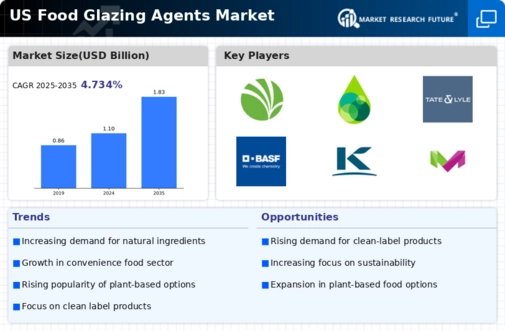Health Consciousness Among Consumers
The food glazing-agents market is also shaped by the growing health consciousness among consumers. As individuals become more aware of the nutritional content of their food, there is a shift towards glazing agents that offer health benefits, such as natural and organic options. This trend is particularly relevant in the context of clean label products, where consumers prefer ingredients that are recognizable and perceived as healthier. The market for natural food glazing agents is expected to witness a growth rate of approximately 6% over the next few years, reflecting this shift in consumer preferences. The food glazing-agents market is adapting to these changes by developing products that align with health trends, thereby catering to a more health-conscious demographic.
Expansion of the Food Processing Sector
The food glazing-agents market is positively influenced by the expansion of the food processing sector in the US. As food processing companies seek to improve product quality and shelf life, the incorporation of glazing agents becomes increasingly prevalent. These agents not only enhance the appearance of food products but also provide protective coatings that can extend freshness. The food processing industry has seen a steady growth rate of around 3.5% annually, which correlates with the rising utilization of glazing agents. This growth indicates a robust demand for food glazing agents, as manufacturers strive to meet consumer expectations for quality and longevity. The food glazing-agents market is thus positioned to benefit from this expansion, as more processed food products require effective glazing solutions.
Innovation in Food Preservation Techniques
Innovation in food preservation techniques significantly impacts the food glazing-agents market. As manufacturers seek to enhance the shelf life and safety of food products, glazing agents are increasingly utilized as effective preservation solutions. These agents can create barriers to moisture and oxygen, thereby prolonging freshness and preventing spoilage. The food glazing-agents market is witnessing advancements in formulation technologies that improve the efficacy of these agents. Recent studies indicate that the use of advanced glazing agents can extend shelf life by up to 30%, making them an attractive option for food producers. This innovation not only meets consumer demands for longer-lasting products but also aligns with industry goals for reducing food waste.
Rising Demand for Aesthetic Food Presentation
The food glazing-agents market experiences a notable surge in demand driven by the increasing consumer preference for visually appealing food products. As consumers become more discerning about food aesthetics, manufacturers are compelled to enhance the visual quality of their offerings. This trend is particularly evident in the bakery and confectionery sectors, where the application of glazing agents can significantly elevate the presentation of products. According to recent data, the market for food glazing agents is projected to grow at a CAGR of approximately 5.2% over the next five years, reflecting the importance of visual appeal in consumer purchasing decisions. The food glazing-agents market is thus adapting to these aesthetic demands, leading to innovations in product formulations that cater to this growing consumer expectation.
Evolving Retail Landscape and E-commerce Growth
The evolving retail landscape, particularly the growth of e-commerce, plays a crucial role in shaping the food glazing-agents market. As online grocery shopping becomes more prevalent, food manufacturers are increasingly focused on product packaging and presentation to attract consumers in a digital marketplace. Glazing agents are essential in enhancing the visual appeal of products, making them more enticing to potential buyers. The e-commerce food market is projected to grow at a CAGR of around 8% in the coming years, indicating a shift in consumer purchasing behavior. The food glazing-agents market is thus adapting to this trend by developing products that not only meet quality standards but also enhance the visual presentation of food items for online sales.




















Leave a Comment